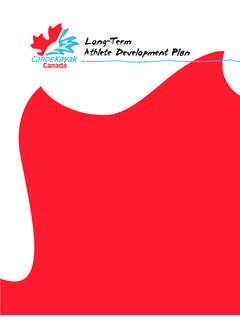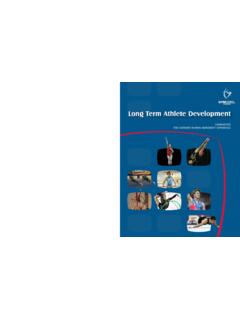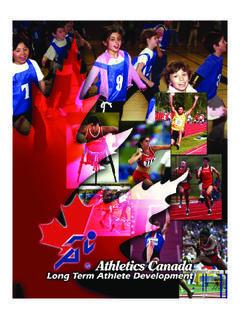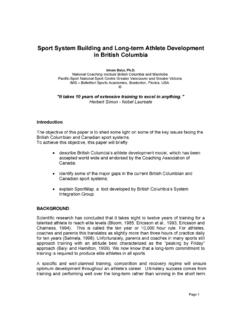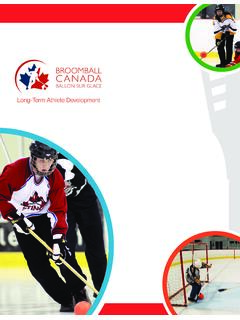Transcription of LTAD Pgs1-19:Layout 1 - Tennis Canada
1 2 Stage 1, 2 Active Start and FUNdamentalsSub-Committee Chair Ari NovickRichard CrowellWayne EldertonConrad PineauKartik VyasStage 3 DevelopingSub-Committee Chair Andre LabelleSimon BartramPeter CameronDaniel CloutierChristine PicherStage 4 ConsolidatingSub-Committee Chair Debbie KirkwoodBen ArmstrongBob BrettRoberto BroginCesar CastandeaGuillaume MarxLuke O LoughlinStage 5, 6, 7 Learning to Perform, Learning to be aProfessional, Living as a ProfessionalSub-Committee Chair Louis BorfigaSylvain BruneauCesar CastanedaGuillaume MarxRobbie MenardJocelyn RobichaudStage 8 Tennis for LifeSub-Committee Chair Julie StaplesRobert BettauerJeff CarmichaelLisa KikulisRichard McInnisAndrew NiskerJohn PayneDanielle SmithIrwin TobiasWheelchair Tennis Sub-CommitteeSub-Committee Chair Severine TamboreroUros BudimacDuncan CampbellWayne EldertonAlain MansuelaNick ParkinJanet PetrasExecutive.
2 Technical and Senior Regional DirectorsJim Boyce Ontario Tennis AssociationDarryl Szafranski Tennis AlbertaRyan Clark Tennis BCRick Bochinski Tennis ManitobaMark Thibault Tennis New BrunswickRoger Keating Tennis Nova ScotiaRyan Maarschalk Tennis NFLDMike Connolly Tennis PEIR ufus Nel, Senior Director Prairie Tennis AllianceJ. F. Manibal Federation Quebecoise de TennisRory Park Tennis SaskatchewanContributorsTennis Canada would like to acknowledge the efforts of a number of individuals across Canada who contributed in various ways to the development of this critical Steering Committee MembersLouis Borfiga, Vice-President.
3 High Performance Athlete DevelopmentDebbie Kirkwood, Director, High PerformanceAndre Labelle, U12 National CoachAri Novick, Director, Coaching DevelopmentJulie Staples, Director, Community DevelopmentAndre Parent, National Fitness CoachColin Higgs, Sport Canada LTAD Expert Work GroupSeverine Tamborero, National Wheelchair CoachCarolyn Trono, LTAD WriterCharles Cardinall, Sport Canada LTAD Expert Work GroupThe steering committee would also like to thank the followingindividuals for their contribution to the development of the development Board CommitteeTony Eames, Chair of the BoardJack GrahamRoger MartinDeborah OrangeMartin WostenholmeAndr e MartinMichael Downey, President and CEOH atem McDadi, Vice-President Tennis DevelopmentKeith RisslingOther contributors: Dr.
4 David Cox, National Team Psychologist,3 ForewordMany elements need to be in place to achieve ongoingsuccess on the national and international Tennis elements help maximize the contribution that thesport of Tennis can make to improve the health andwell-being of Canadian society. The long Term Athlete development (LTAD) model hasbeen developed to ensure Canadians have a clear un-derstanding of the eight stages of development and in-formation on the key components of the Tennis sportsystem. These facets are seamlessly integrated intothe model to help achieve the above objectives. Ten-nis is also a sport that can be played at all levels successfully by people with a phys-ical disability, thus material relating to the wheelchair Tennis game has been integratedthroughout the model.
5 The timing to collectively build this framework could not have been better. Tennis inCanada is thriving. Tennis participationwas up 22% between 2002-2007 with ap-proximately million participants playing regularly in season. National, provin-cial, community and club leaders have partnered to build long term strategic plans andthe level of cooperation among these leaders has reached historic highs, with a clearunderstanding of the roles and responsibilities. The high performance and commu-nity programs have been rejuvenated with the hiring of world-class elite internationalcoaches, and the establishment of a permanent community department.
6 This increasein capacity enhances the strong team currently in place to create a culture of excel-lence for Tennis development . The results are starting to show as national pride is becoming contagious with eachGrand Slam, Olympic or Paralympic performance achieved by our athletes . The highperformance clubs and national training centres are becoming well established witha strong base of scientific support. Recruiting, identifying and nurturing talent hasbeen recognized as a strategic priority. In addition, the Progressive Tennis initiativehas been threaded throughout the model. Progressive Tennis is a terrific tool to in-troduce new participants and young children in a systematic way using age/skill ap-propriate modified balls, racquet and court sizes with a goal to play, serve, rally andscore in no time.
7 At the grassroots level, the strategy of developing multi-sectoralpartnerships to ensure Tennis is meeting and addressing community needs has alsoproved to be a successful and cutting edge approach to grow the game. This model is a direct outcome of years of work and collaboration with staff, partners,community leaders and volunteers. Best national/international practices and researchwere used to develop this model. Special thanks to our staff, board, provincial tennisassociation partners, LTAD steering committee members, sponsors, donors, volun-teers, community champions, supporters, players and all those who contributed tobuilding this very important model many recognized in the acknowledgment thanks are in order to Debbie Kirkwood for her superb work as project leaderon behalf of Tennis Canada .
8 Your ongoing support and contribution inspires us as we collectively build a world-class system. Delivering well-thought out, effective programs that are adaptable tothe diversity within Canadian communities will increase the odds of producing futureGrand Slam champions and ensuring Canadians enjoy Tennis for life. The conditionsare ripe to achieve our vision of being a leading sport and recreational activity na-tionally and to consistently rank among the world s top Tennis nations. Sincerely,Michael S. DowneyPresident and CEOT ennis Canada44 Table of ContentsContributors .. Tennis Canada Mission, Vision and Values.
9 52. What is long Term Athlete development (LTAD)?..63. Why Does Tennis Canada Need an LTAD? ..74. Ten Key Factors Influencing Tennis Canada long Term Athlete development Details on LTAD Physical Stage 1 - Active Start ..25 Stage 2 - Stage 3 - Stage 4 - Stage 5 - Learning to Stage 6 - Learning to Be a Professional ..49 Stage 7 - Living as a Stage 8 - Tennis for Life ..607. Summary Charts - All Competition Competition Pathways9. Coaching Certification and Next Steps: Building the Future - Integration Canada Mission, Vision, ValuesMissionTennis Canada shall lead the growth, promotion and show-casing of the sport of Tennis in Canada , build a system thathelps produce world-class players and foster the pursuit ofexcellence for will be a leading sport and recreational activity nation-ally in Canada , and will consistently rank among the world stop Tennis ; Collaboration; Diversity and Equity; Ethics; Excellence; Fairness and Respect; Healthy Lifestyle; People;Pride; Responsible Citizenship.
10 Of the above are defined internally as follows: Growth refers to growing all aspects of Tennis from participation, coaching, of-ficiating, competition and/or being a fan of Tennis . Promotion refers to promoting the advantages of playing, coaching, officiating,competing and/or being a fan of Tennis . Showcasing refers to the advantages of staging or supporting Tennis events forpublic consumption. Being ranked among the world s top Tennis nations refers to being ranked Top10 internationally as it relates to Davis Cup, Fed Cup, World Team Cup, and withplayers ranked in the Top 50 on the ATP, WTA, ITF rankings.
